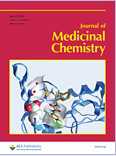J Med Chem:化合物ML267可抵抗疟疾
2012-07-23 T.Shen 生物谷
近日,来自加州大学的研究者首次报道了一种可以抑制引发疟疾的寄生虫关键酶的抑制剂,研究发现为我们开发抗疟疾药物提供了基础,相关研究成果刊登在了国际杂志Journal of Medicinal Chemistry上。 热带疟疾一年可造成超过120万人死亡,很多严重的疾病都是由恶性疟原虫引发,并且其可以通过按蚊在人类中传播。文章中研究者对350,000中化合物进行高通量筛选,有针对性的识别可以抑制寄生
近日,来自加州大学的研究者首次报道了一种可以抑制引发疟疾的寄生虫关键酶的抑制剂,研究发现为我们开发抗疟疾药物提供了基础,相关研究成果刊登在了国际杂志Journal of Medicinal Chemistry上。
热带疟疾一年可造成超过120万人死亡,很多严重的疾病都是由恶性疟原虫引发,并且其可以通过按蚊在人类中传播。文章中研究者对350,000中化合物进行高通量筛选,有针对性的识别可以抑制寄生虫生长发育的关键蛋白的抑制化合物,恶性疟原虫葡萄糖-6-磷酸脱氢酶(PfG6PD)对于其繁殖非常重要。葡萄糖-6-磷酸脱氢酶(G6PD)在恶性疟原虫机体中发挥着关键的催化一步,使得疟原虫可以免受血细胞中的氧化压力损伤,从而为其提供了合适的生存环境。疟原虫生存于感染者的血液中,科学家目的是寻找可以抑制G6PD活性的疟原虫,而并不对人体细胞造成损害,研究者Bode表示,我们并不想干扰人类G6PD的活性而且也不想给人类健康带来负面影响。
以前的科学检测缺少重组体的PfG6PD的检测,因此研究者通过筛选最终筛选出了化合物ML276,ML267是首次报道的选择性的PfG6PD抑制剂,可以阻止红细胞中的恶性疟原虫的生长,甚至可以阻止当前耐药的疟原虫的生长。ML267为未来抗疟疾疗法的成功进行提供了重要的线索和思路。
编译自:Novel anti-malarial drug target identified

doi:10.1021/jm300833h
PMC:
PMID:
Discovery of a Plasmodium falciparum glucose-6-phosphate dehydrogenase 6-phosphogluconolactonase inhibitor (R,Z)-N-((1-ethylpyrrolidin-2-yl)methyl)-2-(2-fluorobenzylidene)-3-oxo-3,4-dihydro-2H-benzo[b][1,4]thiazine-6-carboxamide (ML276) that reduces parasite growth in vitro
Janina Preuss, Patrick Maloney, Satyamaheshwar Peddibhotla, Michael P Hedrick, Paul Hershberger, Palak Gosalia, Monika Milewski, Yujie Linda Li, Eliot Sugarman, Becky Hood, Eigo Suyama, Kevin Nguyen, Stefan Vasile, Eduard Sergienko, Arianna Mangravita-Novo, Michael Vicchiarelli, Danielle McAnally, Layton H Smith, Gregory P Roth, Jena Diwan, Thomas D.Y. Chung, Esther Jortzik, Stefan Rahlfs, Katja Becker, Anthony B. Pinkerton, and Lars Bode
A high throughput screen of the NIH’s MLSMR collection of ~340,000 compounds was undertaken to identify compounds that inhibit Plasmodium falciparum glucose-6-phosphate dehydrogenase (PfG6PD). PfG6PD is essential for proliferating and propagating P. falciparum and differs structurally and mechanistically from the human ortholog. The reaction catalyzed by glucose-6-phosphate dehydrogenase (G6PD) is the first, rate-limiting step in the pentose phosphate pathway (PPP), a key metabolic pathway sustaining anabolic needs in reductive equivalents and synthetic materials in fast-growing cells. In P. falciparum the bifunctional enzyme glucose-6-phosphate dehydrogenase-6-phosphogluconolactonase (PfGluPho) catalyzes the first two steps of the PPP. Because P. falciparum and infected host red blood cells rely on accelerated glucose flux, they depend on the G6PD activity of PfGluPho. The lead compound identified from this effort, (R,Z)-N-((1-ethylpyrrolidin-2-yl)methyl)-2-(2-fluorobenzylidene)-3-oxo-3,4-dihydro-2H-benzo[b][1,4]thiazine-6-carboxamide, 11, (ML276), is a submicromolar inhibitor of PfG6PD (IC50 = 889 nM). It is completely selective for the enzyme’s human isoform, displays micromolar potency (IC50 = 2.6 μM) against P. falciparum in culture, and has good drug-like properties, including high solubility and moderate microsomal stability. Studies testing the potential advantage of inhibiting PfG6PD in vivo are in progress.
作者:T.Shen
版权声明:
本网站所有注明“来源:梅斯医学”或“来源:MedSci原创”的文字、图片和音视频资料,版权均属于梅斯医学所有。非经授权,任何媒体、网站或个人不得转载,授权转载时须注明“来源:梅斯医学”。其它来源的文章系转载文章,本网所有转载文章系出于传递更多信息之目的,转载内容不代表本站立场。不希望被转载的媒体或个人可与我们联系,我们将立即进行删除处理。
在此留言





#化合物#
33
#抗疟疾#
39
#Med#
48